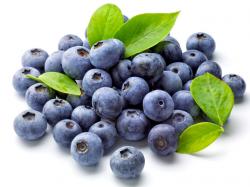Wild Blueberries Show Potential For Reducing The Risk Of Type 2 Diabetes
July 24, 2012 | 3 min to read

Portland, ME – Men and women who regularly consume higher amounts of anthocyanin-rich fruits, particularly blueberries, show a reduced risk for type 2 diabetes. That’s the finding of a recent study conducted by researchers at the Harvard School of Public Health.
The researchers discovered that people who increased their intake of anthocyanins by eating more than two servings of blueberries per week had a lower risk of type 2 diabetes compared to those who ate less than one serving of blueberries per month.
Anthocyanins are highly concentrated in the deep blue pigments of Wild Blueberries, which contain higher levels of anthocyanins than many other foods. They belong to a group of natural compounds, called flavonoids, found in the skins of many plants that have high antioxidant capacity and other bioactivity.
Researchers focused on the relationship between anthocyanin consumption and type 2 diabetes by examining data from over 200,000 men and women participating in long-term health studies.
“In our large prospective study, we found that higher consumption of blueberries was associated with lower risk of type 2 diabetes, possibly due to their high content of anthocyanins,” said Walter Willett, MD, DrPH, Professor of Epidemiology and Nutrition at Harvard School of Public Health and the study’s lead author. “This finding should stimulate further research in this area, but in the meantime it is one more reason to include blueberries in our choices of fruits and vegetables.”
Type 2 diabetes is the most common form of diabetes, and affects millions of Americans. People with diabetes are at higher risk for Alzheimer’s disease, heart disease and other serious health problems. Reducing the risk of diabetes can have a major impact on a person’s health.
“This study is the latest in a growing body of health-related research showing that making flavonoid- and anthocyanin-rich whole foods like Wild Blueberries part of a daily diet is a smart move,” said Susan Davis, MS, RD, nutrition advisor to the Wild Blueberry Association of North America.
A 2010 study by researchers at Louisiana State University, found that daily consumption of whole blueberries reduced the rate at which people with a high risk for type 2 diabetes actually developed the disease.
Wild Blueberries offer a host of potential benefits for everyone, not only people at risk of diabetes. They are an antioxidant leader, have a low glycemic index, contain only 71 calories per one-cup serving, and are high in fiber.
In addition to diabetes, researchers are focusing on a wide range of potential health benefits related to Wild Blueberries, in areas such as brain health, cancer prevention, gut health, heart health and metabolic syndrome.
Wild Blueberries are frozen fresh at the peak of antioxidant freshness and only available in the freezer case at grocery stores. Because they are available frozen throughout the year, it is easy to make them a regular part of a healthy diet.
Frozen fresh Wild Blueberries maintain their flavor, texture, and – most importantly – their nutritional properties. The pearl-sized berries may be eaten whole, blended into smoothies and beverages, added to recipes or sprinkled on cereal or desserts.
For a variety of easy-to-make breakfast, dinner, dessert and drink recipes that make it easy to add two weekly servings of Wild Blueberries to a healthy diet, visit the Wild Blueberry Association of North America’s web site at http://www.wildblueberries.com/recipes.
“Adding Wild Blueberries to a healthy diet is easy,” noted Davis, “and doing so has the potential to reduce the risk of developing chronic and age-related health issues.”
“Dietary Flavonoid Intakes and Risk of Type 2 Diabetes in US Men and Women”
was published earlier this year in the American Journal of Clinical Nutrition.
About the Wild Blueberry Association of North America (http://www.wildblueberries.com)
The Wild Blueberry Association of North America is a trade association of growers and processors of Wild Blueberries from Maine and Canada, dedicated to bringing the Wild Blueberry health story and unique Wild Advantages to consumers and the trade worldwide.
For news, recipes, and related health information about Wild Blueberries, visit http://www.wildblueberries.com, http://www.wildblueberryhealthblog.com
Source: The Wild Blueberry Association of North America
